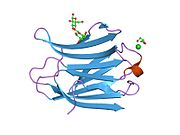Galectin-3
Ensembl | |||||||||
|---|---|---|---|---|---|---|---|---|---|
| UniProt | |||||||||
| RefSeq (mRNA) | |||||||||
| RefSeq (protein) |
| ||||||||
| Location (UCSC) | Chr 14: 55.12 – 55.15 Mb | Chr 14: 47.61 – 47.62 Mb | |||||||
| PubMed search | [3] | [4] | |||||||
| View/Edit Human | View/Edit Mouse |
Galectin-3 is a protein that in humans is encoded by the LGALS3 gene.[5][6] Galectin-3 is a member of the lectin family, of which 14 mammalian galectins have been identified.[7][8]
Galectin-3 is approximately 30 kDa and, like all galectins, contains a carbohydrate-recognition-binding domain (CRD) of about 130 amino acids that enable the specific binding of β-galactosides.[7][9][10][11]
Galectin-3 (Gal-3) is also a member of the beta-galactoside-binding protein family that plays an important role in
Galectin-3 is encoded by a single gene, LGALS3, located on chromosome 14, locus q21–q22.
Function
Galectin-3 has an affinity for
This
Galectin-3 associates with the
The functional roles of galectins in cellular response to membrane damage are rapidly expanding.[18][19][20] It has recently shown that Galectin-3 recruits ESCRTs to damaged lysosomes so that lysosomes can be repaired.[19]
Clinical significance
Fibrosis
A correlation between galectin-3 expression levels and various types of fibrosis has been found. Galectin-3 is upregulated in cases of liver fibrosis, renal fibrosis, and idiopathic pulmonary fibrosis (IPF). In several studies with mice deficient in or lacking galectin-3, conditions that caused control mice to develop IPF, renal, or liver fibrosis either induced limited fibrosis or failed to induce fibrosis entirely.[21][22][23] Companies have developed galectin modulators that block the binding of galectins to carbohydrate structures. The galectin-3 inhibitor, TD139 and GR-MD-02 have the potential to treat fibrosis.[23]
Cardiovascular disease
Elevated levels of galectin-3 have been found to be significantly associated with higher risk of death in both acute decompensated heart failure and chronic heart failure populations.
Galectin-3 also may be used as a
Cancer
The wide variety of effects of galectin-3 on
Galectin-3
The roles of galectins and galectin-3, in particular, in cancer have been heavily investigated.[30] Of note, galectin-3 has been suggested to play important roles in cancer metastasis.[31]
Clinical applications
Cardiovascular risk indicator
Galectin-3 is
Drug development
Biomarkers
Galectin-3 is increasingly being used as a diagnostic marker for different cancers. It can be screened for and used as a prognostic factor to predict the progression of the cancer. Galectin-3 has varying effects in different types of cancer.[40] One approach to cancers with high galectin-3 expression is to inhibit galectin-3 to enhance treatment response.[41]
Interactions
LGALS3 has been shown to
In melanocytic cells LGALS3 gene expression may be regulated by MITF.[45]
References
- ^ a b c GRCh38: Ensembl release 89: ENSG00000131981 - Ensembl, May 2017
- ^ a b c GRCm38: Ensembl release 89: ENSMUSG00000050335 - Ensembl, May 2017
- ^ "Human PubMed Reference:". National Center for Biotechnology Information, U.S. National Library of Medicine.
- ^ "Mouse PubMed Reference:". National Center for Biotechnology Information, U.S. National Library of Medicine.
- PMID 2009535.
- PMID 8063692.
- ^ PMID 16478649.
- ^ a b "Entrez Gene: LGALS3 lectin, galactoside-binding, soluble, 3".
- ^ PMID 12223274.
- ^ PMID 12223271.
- ^ S2CID 36367366..
- S2CID 1955109.
- ^ PMID 15520318.
- S2CID 8348013.
- PMID 19098114.
- PMID 19747906.
- PMID 17148658.
- PMID 29625033.
- ^ PMID 31813797.
- PMID 31995728.
- PMID 16549783.
- PMID 18202187.
- ^ PMID 22095546.
- PMID 16979009.
- PMID 20130888.
- S2CID 32686826.
- PMID 22513778.
- S2CID 1252812.
- ^ PMID 21974805.
- S2CID 4849835.
- PMID 23047680.
- ^ Ross, D. "Abbott's Galectin-3 Test Provides Doctors in Europe with New Tool for Assessing the Prognosis of Chronic Heart Failure Patient". Retrieved 28 November 2013.
- ^ Brechka N (2009). "Putting the Squeeze on Cancer". Retrieved 28 November 2013.
{{cite journal}}: Cite journal requires|journal=(help) - ^ PMID 23230309.
- S2CID 205268879.
- ^ "Galectin Therapeutics' Preclinical Data Published in PLOS ONE Show Its Galectin Inhibitors Reverse Cirrhosis and Significantly Reduce Fibrosis and Portal Hypertension". Globe Newswire. Retrieved 28 November 2013.
- S2CID 211133881.
- PMID 32466889.
- S2CID 128360958.
- PMID 22039439.
- PMID 22207425.
- PMID 1917996.
- PMID 8390986.
- PMID 11146440.
- S2CID 24698373.
This article incorporates text from the United States National Library of Medicine, which is in the public domain.






